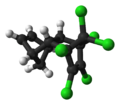Aldrin facts for kids
Aldrin is a chemical that was once widely used to kill insects, like termites, locusts, and the young forms (called larvae) of Click beetles. It was a very strong insecticide.
Most plants and animals that came into contact with aldrin would change it into another chemical called Dieldrin.
Aldrin is considered a dangerous chemical. Because of its harmful effects, its creation, use, and sale have been banned since 2004 under an international agreement called the Stockholm Convention on Persistent Organic Pollutants.
Why Aldrin is Dangerous
Aldrin is a neurotoxin, which means it can harm the nervous system, including the brain. People who breathed in aldrin could get headaches. In more serious cases, it could even cause seizures.
When aldrin enters the human body, the liver tries to change it into dieldrin. This change helps the body get rid of the chemical. However, this process is very slow. Aldrin can stay in the body for a long time, sometimes for about a year.
Scientists also believe that aldrin might be a teratogen. This means it could cause problems or birth defects in unborn babies if a pregnant person is exposed to it. It is also thought to cause cancer.
How Aldrin Was Made
Aldrin was made by mixing two other chemicals: hexachlorocyclopentadiene and norbornadiene. This process is a special type of chemical reaction called a Diels–Alder reaction.
The chemical aldrin was named after a German chemist named Kurt Alder. He was one of the scientists who helped discover the type of reaction used to make aldrin.
Between 1946 and 1976, a huge amount of aldrin and similar chemicals were produced. It's estimated that about 270 million kilograms were made during that time.
When aldrin was in soil, on plants, or inside the bodies of insects, it would change into dieldrin. Dieldrin was even more effective at killing insects than aldrin itself.
Images for kids
See also
 In Spanish: Aldrina para niños
In Spanish: Aldrina para niños




